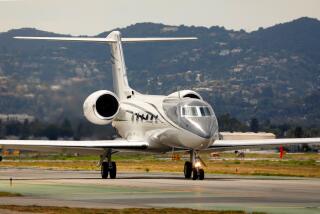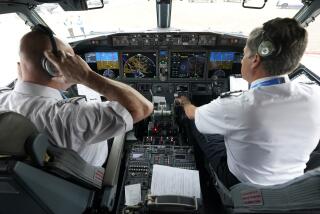Drug Battle Targets Private Planes : Law Tells FAA to Alter Rules to Curb Narcotics Smuggling
- Share via
WASHINGTON — When a small group of professional drug smugglers set about enlarging their fleet of private aircraft, they found that obtaining the proper papers that would permit them to fly their illicit cargo was easier than getting a driver’s license.
In securing aircraft ownership certificates from the Federal Aviation Administration, they listed themselves as a nonexistent corporation with a fictitious address as their headquarters. To avoid the possibility that the FAA might try to locate the person who signed on behalf of the “corporation,” the smugglers needed only to make the signature illegible.
Later, when the group retrofitted some of their planes with larger fuel tanks to increase their range, the smugglers decided against reporting the alterations, as required by law. No agency inspectors ever checked their modified planes, even though they were often parked openly at small airports.
Estimated Number of Flights
Such routine evasion of FAA regulations, described in this instance to authorities by a federally protected witness, has become a major focus of U.S. law enforcement officials. The congressional Office of Technology Assessment estimates that 1,300 to 3,500 general aviation flights are used to smuggle drugs each year--that’s about 3.5 to 10 each day, most of them across the Southern borders of the United States, including the California-Mexico line.
Well aware of such troubling statistics, members of Congress and officials of the Customs Service and the Drug Enforcement Administration have become increasingly concerned that the FAA may be playing into the hands of criminals.
“Two-thirds of all smuggled narcotics comes in on small aircraft,” said Rep. Glenn M. Anderson (D-San Pedro), chairman of the House Public Works and Transportation Committee. “Improperly and illegally registered aircraft are contributing substantially to the problem of drug smuggling,” he said.
The FAA acknowledges the problem but stresses that it is not a law enforcement agency, having been created essentially to promote air safety. And some officials at the aviation agency believe that drug smuggling in the skies is so pervasive that little can be done by the FAA to significantly reduce the problem.
Moreover, any reforms in the system face strong opposition from a powerful lobby of hundreds of thousands of aircraft owners and pilots determined to fight any effort that would result in higher operating costs. And the general aviation community has won the support of many FAA officials.
Although improvements in the FAA system will not eradicate all narcotics smuggling, law enforcement officials believe that a better paper trail of aircraft owners and pilot licenses could greatly assist in identifying suspects.
To that end, Anderson’s committee inserted a little-known provision in this year’s drug enforcement bill that will give the FAA 10 months to revise its regulations governing small aircraft and private pilots. The new law, signed by President Reagan last Friday, directs the FAA to prevent the registration of private aircraft to fictitious people, for example, and it imposes criminal penalties for forging aircraft certificates and placing false markings on aircraft.
In the meantime, however, law enforcement officials engaged in the war against drugs fear that scores of drug dealers will continue to fly with ease through loopholes in FAA regulations.
A federally protected witness known only as “Mr. Smith” told Anderson’s committee that he helped smugglers evade aircraft registration procedures more than 40 times. He said that his employers were Americans, Colombians and Bahamians.
Smith, who is a pilot, said the system is easy to abuse. Because sellers of aircraft usually leave it to the buyers to take care of their new titles, drug traffickers who buy planes often find it to their advantage to leave the plane registered to a previous owner, even at the risk of forfeiting their ownership if a dispute over the plane develops.
The aircraft is simply a cheap tool in the smuggling trade, far less valuable than the high-priced cocaine it carries, the witness said. Keeping his identity hidden is far more important to a smuggler than forfeiting his aircraft--if, for example, the smuggling flight is intercepted.
Smith said the pilots smugglers hire to ferry drugs ask few questions of the owners. Some pilots are convicted felons, he said, but the FAA does not check into their backgrounds and does not even require a photograph before issuing a pilot’s license.
“It’s much harder to get a driver’s license,” Smith told the committee.
The undercover witness also testified that “many aircraft I was familiar with had obvious modifications to their fuel systems” that never were reported to the FAA, despite a requirement that such changes be reported.
Some had wing-tip tanks installed to give them greater range, he said, and others had external modifications designed to make more room for cargo--in this case, narcotics. Law enforcement officials say wing-tip tanks often signal a smuggler’s plane because longer distances can be flown from Latin America without the need for refueling.
FAA inspectors at small airports are supposed to ask for documentation when they see fuel tank modifications, Smith said, but he and his colleagues never were approached about this.
William Rosenblatt, director of enforcement for the Customs Service, said FAA officials have become more alert to the problems of drug interdiction since T. Allan McArtor became FAA administrator last year.
“They’ve been wonderful in sharing what data they have,” Rosenblatt said in an interview. “However, insofar as enforcing their regulations on private aircraft, going after pilots that have been convicted and tightening up identification procedures, they have dragged their feet somewhat.”
David L. Westrate, the DEA’s assistant administrator for operations, agreed with that assessment, stressing that more background checks on pilots are needed, besides better registration records covering aircraft.
Westrate, Rosenblatt and other law enforcement officials are also concerned that small aircraft can fly across U.S. borders at any point. “We’ve discussed with FAA a proposal for setting up certain corridors that private planes must use to fly into the United States,” Westrate said. “Anyone outside these corridors would be suspected of smuggling.
“We’d also like to see the FAA require that identification numbers be painted on top of the wings so that our chase aircraft can look down on them.”
But Westrate noted that private aircraft owners, who include many well-to-do business executives, represent “a very powerful lobby.” In past years, the lobby has objected to any new proposals that add to the costs of airplane owners or impinge on their freedom.
This lobby, known as the Aircraft Owners and Pilots Assn., is a nonprofit national organization of 265,000 owners and pilots. It has been lukewarm, at best, to any wholesale changes in the FAA’s current system of regulating small airplanes or pilots.
John Yodice, general counsel of the association, said any new private aircraft regulations developed by the FAA ought to be “reasonable,” contending that current rules “are not poor or inadequate” despite the claims of some law enforcement officials.
John L. Baker, the association’s president, said: “We have a serious concern that the burdens imposed on the law-abiding may not be justified by the results expected to be achieved (in the drug war).”
Ken Lauterstein, an FAA official who is heading a 10-member study group to improve aircraft registration procedures, frankly conceded that the war on drugs “pointed out loopholes in the system” and said his agency is anxious to improve the system.
“We want to meet the needs of the law enforcement community,” Lauterstein said. Although the FAA had not previously focused on the problem, he said, it “definitely” will improve procedures by the 10-month deadline.
More to Read
Sign up for Essential California
The most important California stories and recommendations in your inbox every morning.
You may occasionally receive promotional content from the Los Angeles Times.










